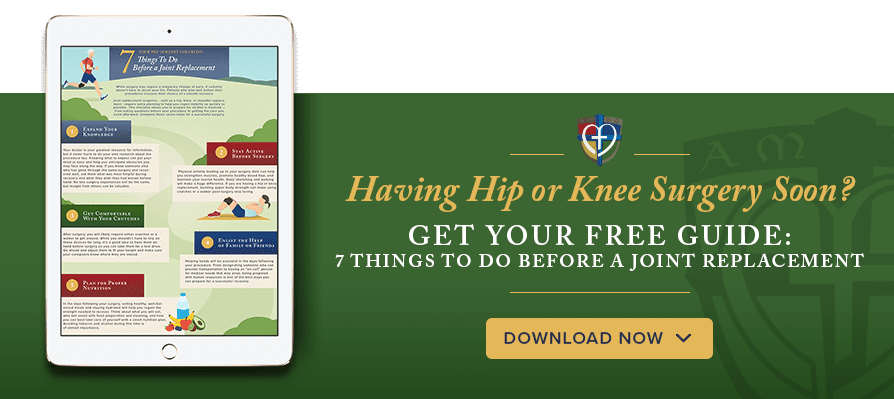
If you’ve already scheduled your joint replacement surgery, less pain and newfound mobility are within sight. However, you may be wondering what to expect during the recovery period. This list will help you know what to anticipate in the days and weeks following your surgery and prepare for a successful recovery.
Learn New Ways to Navigate
While you are still in the hospital, you’ll receive physical therapy. One goal of this rehabilitation is to teach you how to safely navigate while you recover.
- Take the Weight Off – You will temporarily need a walker, cane, or crutches. As you build strength and heal, you can gradually put more weight on the affected side and reduce the use of these devices.
- Step Up – Stairs and curbs will present some challenges. In the early days of recovery, you may only be able to manage two or three steps. Rehabilitation will help you build up to more stairs.
- Daily Activities – You will initially have restrictions on motions like bending over or crossing your legs. Your rehabilitation team will teach you how to safely get up and down from a chair or the toilet, take a shower, navigate a kitchen, and complete other daily activities.
- Home Safety – It’s best to remove throw rugs to avoid tripping. You may want to have a raised toilet seat, shower seat, and grab bar in the bathroom. You’ll also need to make sure furniture is arranged to have enough room for a walker or crutches.
Prevent Complications
The two complications to watch for after surgery are blood clots and infection.
- Blood clots – To prevent a blood clot in your leg or pelvis, your doctor may prescribe a blood thinner medication and suggest wearing support hose. It is also important to engage in as much movement and exercise as your doctor and therapy team recommend.
If you have pain in your leg unrelated to your incision, severe swelling in any part of your leg, or tenderness, contact your doctor immediately.
- Infection – Infection after joint surgery is rare. Be sure you understand instructions about changing dressings on your wound and how long to wait after surgery to bathe or shower. Your doctor will recommend taking antibiotics before having dental work or any type of surgery done.
Should you have a persistent fever, chills, or increasing redness or swelling of your surgical site, contact your surgeon’s office immediately.
Curb the Pain
You will be given medication for your pain. Some patients are hesitant to take medication, but trying to tough it out and staying in pain can actually delay your recovery. Pain control helps you fully participate in rehabilitation exercises and rest better at night. Be sure to tell your nurse, doctor, or therapist if you feel like the medication is not providing relief. You can also use ice packs or heat as directed by your physician or therapist.
Partner With Your Therapists
Your physical and occupational therapists can serve as valuable partners in your recovery. You will receive therapy while you are in the hospital and continue your rehabilitation for six to eight weeks. The advantages of rehabilitation include:
- Your prescribed exercises will help your joint heal properly, minimize scar tissue, and strengthen muscles surrounding the new joint.
- Therapists are trained to make sure your environment is safe and can give you tips for getting around your home and in and out of the car accident-free.
- If you are not progressing as expected or having difficulty, your therapist can help relay that information to the doctor. In some cases, your therapy plan may need to be adjusted for the best outcome.
Making the Best Rehabilitation Choice
Before your surgery, you will have the option to select a rehabilitation provider. Depending on your health, your home environment, and the amount of help you have available, you may choose a short-term rehabilitation program at an inpatient facility or to receive therapy at home on an outpatient basis. The best choice will depend on your individual situation.
You can download a free guide to the rehabilitation selection process today. Your free e-book includes a four-step assessment and questions to ask potential rehabilitation providers. Get your free e-book: The Road Back to Mobility: Selecting Short-Term Rehabilitation Services.

